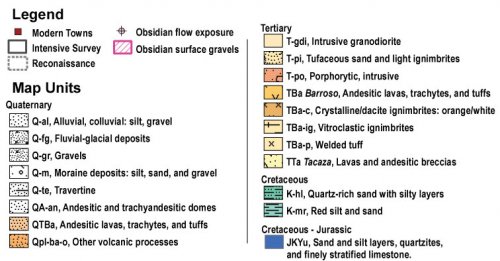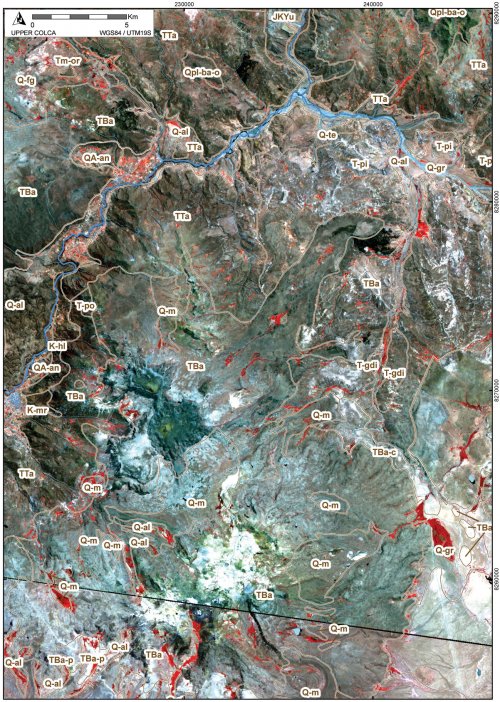4.3.1. A geological descent of the upper Colca drainage
If one measures the river from its birthplace in Imata near the department of Puno, among a fan of tributaries that flow into Lake Jayuchaca at around 4500 masl, to its final exit into the Pacific Ocean at Camaná, the course of the Colca River is approximately 450 km (Parodi 1987: 31) with an average gradient of 1º. The river that begins in the low gradient marshlands of the Peruvian altiplano becomes increasingly steep as it descends into one of the world's deepest canyons, finally flattening out as it emerges on the littoral batholith only 48 km from the sea.
For the first 70 km from its origin the Colca River trends northwest at a low gradient, open channel descending towards the community of Huinco (3950 masl). This lower portion of this low gradient section of the Colca drainage is under the 250 million m3Condoroma reservoir, a product of the 1970s Majes Hydroengineering Project that, combined with water contributed by tunnel from the much larger Angostura reservoir in the Apurimac drainage, has resulted in a sustained year-around flow in the Colca between here and the Tuti diversion dam (Gelles 2000;Maos 1985). At Huinco, the river turns abruptly to the south-west where it continues to descend as a gentle channel, cutting through the Miocene lava formation known as Tacaza as well as wind-scoured river terraces. Immediately before entering the northern edge of Block 3 of our study area, the river cuts through strata of uplifted Cretaceous limestone striking west-north-west and forming outcrops and rock shelters on the edges of the upper river terraces (Figure 4-15). Downstream at the confluence with the Llapa River the Colca River returns again to the Tacaza formation for five more kilometers before entering the Inca formation, an andesitic exogenous dome dating to the Middle Pleistocene. This Quaternary formation fills the upper Colca valley from this point downstream to near the town of Coporaque and Yanque where fluvial conglomerates overlie it as a result of natural damming of the river by mudslides.
In its descent, 5 km below Sibayo, the incising of the Colca River begins immediately upon entering the recent exogenous dome of the Inca formation, an the river remains incised until it exits the Colca canyon approximately 100 km downstream. The Llapa River, which joins the Colca from river-left at Sibayo, emerges from the sandy tuff layers known as the Castillo de Callallituff formations (Noble, et al. 2003) and the Chalhuanca rhyolite dome fields to the south-east of Callalli. The entrenched Colca River descends more rapidly upon entering the Inca formation approximately 10 km downstream with perennial tributary streams entering primarily from glacierized stratovolcanoes that ring the Colca Valley. The first of these tributary streams are the creeks entering from the north upstream of Tuti draining the southern and eastern flanks of the Nevado Mismi volcano, while streams that form just on the other side of Mismi have recently been confirmed by a National Geographic expedition in 2000 to be the source of the Amazon. Immediately upstream of the town of Tuti a diversion dam was constructed across the Colca where the river is entrenched in a ravine 50m deep. At this point water collected by the Majes Project is diverted into a system of canals and tunnels along the south bank of the Colca that finally crosses into the fertile Pampa de Majes near the Pacific coast.
Below Tuti, the Colca river channel is deeply incised into Quaternary exogenous domes. Continuing downstream, the river turns west, again becomes entrenched, and begins dropping more steeply in the vicinity of Chivay. The geology, geomorphology and soils of the main Colca valley have been well-studied in the past several decades as a result of the "Colca Valley Terrace Project" organized by William Denevan (1986;1988;Denevan, et al. 1987) and more recent reviews of research in the main Colca valley can be found in dissertations by Wernke (2003: 34-66) and Brooks (1998: 57-84). In its steep westward drop to the Pacific littoral the river subsequently enters the 3,270m deep Colca canyon, the third deepest canyon in the world after the Yarlung Tsangpo (Tibet) and the Cotahuasi (Perú). Here the river cuts through folded sedimentary and metamorphosed layers predominantly belonging to the Yura group (Jurassic and Cretaceous) until it emerges as the Majes River on to the large alluvial plain that leads to the sea.
Cartographic sources:(Davila M. 1988;Davila M., et al. 1988;Ellison and Cruz 1985;Hawkins and Cruz 1985;Klinck and Palacios M. 1985;Palacios, et al. 1993), and 2003 field observations.
Figure 4-14. Legend showing geological map units in maps that follow.
Figure 4-15. Geological map units and 2003 Survey Block boundaries (in gray) for the Upper Colca project study area. Legend shown in preceding figure.
Figure 4-16. Geological map units shown on ASTER scene from 28 Sept 2000; legend is shown in Figure 4-14. In general, red pixels show areas of photosynthesizing vegetation (bofedales).



